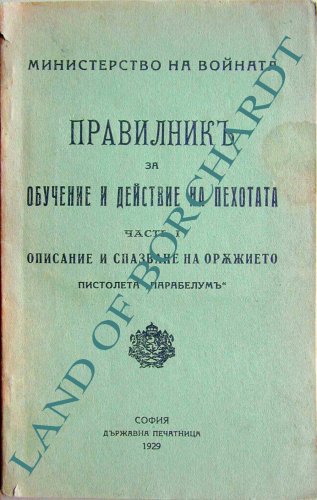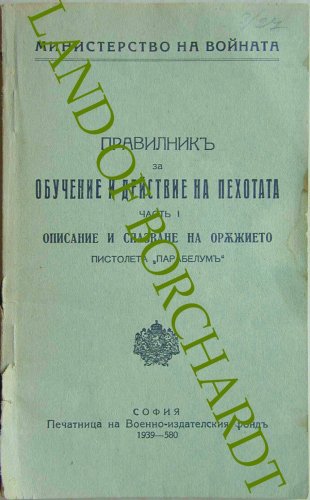Bulgarian instruction manual for the Model 1911 Bulgarian Luger

 1929 manual 1939 manual Mouse over to see the next page. |
Show Cover Show Cover: English translation |
|
Featured above is an original Bulgarian instruction manual for the Model 1911 Bulgarian Luger. The Model 1911 is the Bulgarian designation given the P.08 Imperial German Army Luger adapted by the Bulgarian military in 1911. The Bulgarian contract was awarded in 1911 for 10,000 P.08 style Bulgarian Lugers, with slight modifications requested by the Bulgarian military. It is extremely rare and until now unpublished in any Luger book or periodical. The cover description of the manual is entitled “The training and Operation of the Infantry”. The pale green front and rear cover of the 5” x 7”, 88 page manual is completely written in the Bulgarian Cyrillic language. The title, along with the size or number of pages in the manual, suggests more material being discussed than the use of the M1911. Yet apparently the whole manual is dedicated to the M1911 as most all tables and illustrations featured are exclusive to the M1911 (P.08) as “Part 1” on the cover page would indicate. The cover and inside cover page show the original national Bulgarian crest in effect at the time of the (original) publication. There is no doubt the manual was written mainly for the Bulgarian Model 1911. However, illustrations of the old and new model 7.65 mm 4-¾” barrel used in the manual suggest that the manual might also be applicable to the 1900 and 1906 Bulgarian models. Also, any of the P.08 components would be available for illustrations at the time of printing and adequate in discussing and describing the use of the Model 1911. One possible reason for illustrations showing components of both the old and new model Luger in 30 caliber is that the Bulgarian military ordered small quantities of the old and new model Lugers in 1901-1902 and 1908, of which a small amount may have been in inventory as of 1911. Certainly a complete and thorough translation of the manual would reveal the reasons for the use of the 4 ¾” barrel 30 caliber illustrations. One set of illustrations in the subject manual shows period ammunition available at the time of the original manual printing, specifically showing detailed dimensioned drawings of the DWM K 9 11 headstamp with a flat style bullet or projectile (Flachspitzengeschoß). This is the first instance of ammunition specifically identified for the Bulgarian Luger, Model 1911 and suggests this particular German military round was recommended and/or purchased for use with the M1911 by the Bulgarian military. It is interesting that the original ammo illustration was not updated with this 1939 reprint, since the Bulgarian State Military Factory in Kazanlak (Казанлък) had started indigenous manufacture of 9 mm ammunition specifically for the Parabellum in 1933. Until then, the Bulgarians had relied on imports from DWM, evidently of German military pattern ammo and so headstamped, and on later post WWI contracts with RWS. A P.08 illustration was crudely modified to show a Bulgarian language Cyrillic marked extractor and thumb safety area yet did not relocate the lanyard loop from the rear of the frame to the lower extremity of the rear gripstrap. Interestingly other illustrations in the manual do correctly show the lanyard loop affixed to the lower rear gripstrap. Nowhere in the manual illustrations does it show the M1911 (oбp. 1911 rод) with the simplified Bulgarian crest on the middle toggle link nor the DWM logo over the chamber. A few pages of this manual were professionally translated to get a feel for the materiel. The cover page translation goes a long way in certifying the authenticity of the manual, as it identifies it as being printed by the Bulgarian government.
Rules The Training And Operation Of The Infantry Part 1 Description And Observation Of the Specifications Of The Weapon: The Automatic Pistol „PARABELLUM” SOFIA Military Publishing Printing House 1939 – 580 The apparent date of 1939 on the front cover conflicts with the assertion that the manual was printed in 1911. It may not be a date but some sort of manual identification number. The significance of the number 580 after the number 1939 is not known. Certainly the contents and the Bulgarian crest on the cover date the manual to no later than 1911. However, the date of July 30 1929 found at the top of page 3 (shown in illustration below) complicates the dating or iteration of the manual. This is an apparent approval date of the document printing by a Major General N. BAKARDZHIEV of the (Bulgarian) War Ministry.
 Mouse over to see English translation. There is no statement anywhere in the document indicating a first edition (1911), second edition (1929) or third edition (1939) printing. The July 30, 1929 approval statement on page 3 could be for reasons other than document approval. Based on the above information, one probable conclusion is that this manual represents at least a third printing (1939); the original being the year after the contract was awarded in 1911 and the second printing in July 1929. Amazingly nothing was changed in the manual, as a minimum professional translation of key sections of the manual indicate the original period content and format and no additional illustrations or text material beyond 1911. Apparently significant quantities of the 1910 10,000 order of the DWM P.08 automatic pistol, (designated M1911 by the Bulgarians) survived the two Balkan Wars of 1912-13 and World War 1. The M1911 was still in service in significant quantities and part of the Bulgarian arsenal in 1939, enough so to warrant additional printings of the original manual. The M1911 (P.08) was still the official sidearm of the Bulgarian military and remained so even after “joining” the axis pact as a German ally in 1941. The Bulgarians obtained an additional 5,600 unwanted Pistolen 08 from the Heereswaffenamt after procurement had ceased in 1942. The use of the early 1900s style Bulgarian crest on the manual cover and inside cover, similar to the crests used on the 1900 and 1906 Bulgarian Luger chamber top, would still be contemporary to 1939 as the country, although not part of the old Ottoman Empire was still a Monarchy ruled by King Boris III. The style of the crest did not change for the country in 1911 but was simplified only to accommodate or fit the M1911 middle link but was modified by the Communist dictatorship in approximately 1945 until 1990 when Bulgaria declared its independence due to the disintegration of the Soviet Union. The complete Rampant Lion crest was restored as the Bulgarian national emblem. There is one surviving original 1912 dated instruction manual that deals with the Bulgarian M1911 Luger. Only the cover is available for this article. The owner of the manual indicates that it does not contain any illustrations. The only other period Luger instruction manual that vaguely resembles the subject manual regarding the mixed use of the P.08 and the old and new model illustrations is an extremely rare 1908 Portuguese manual.
Footnote: |
 Home page
Home page